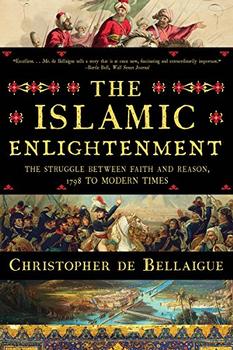Summary | Excerpt | Reviews | Beyond the book | Read-Alikes | Genres & Themes | Author Bio

The Forgotten Uprising in Islam's Holiest Shrine and the Birth of al-Qaeda
by Yaroslav TrofimovMany books claim to tell the untold story of whatever the subject
happens to be, but few can actually live up to the claim quite as well as
Yaroslav Trofimov's second book, following
Faith at War: A Journey on the Frontlines of Islam, from Baghdad to Timbuktu
(2005) which, as the title suggests, reports on the infamous (in some parts of the world) but virtually unknown (in other parts of the world) siege of the Sacred Mosque of Mecca*.
It is a thrilling historical narrative of the events that took place in Mecca
over two weeks at the dawn of the Islamic 15th century, offering hitherto
undisclosed details that provide an instructive introduction to Muslim
fundamentalist terrorism while clearly connecting the dots between then and now.
The 1979 siege of the Sacred Mosque of Mecca, in which tens of thousands were held hostage and about 1,000 were killed, was led by radical Islamist Juhayman al Uteybithat, backed by a small army of followers from many parts of the world, in protest of the Saudi government's corruption and its alliance with the West, most specifically the USA. The Saudi royal family quickly showed themselves incapable of breaking the siege themselves, so they called in French special forces who entered the Mosque and took control.
Some of those formerly loyal to the House of Saud (the hereditary monarchs of Saudi Arabia - see sidebar), such as Osama bin Laden, were so shocked that infidels had been allowed to enter the holiest place of Islam that they become radicalized opponents of the regime, forming a group that eventually became
known as Al-Qaeda which, in one of life's great ironies, was, and probably still is, funded in large
part by the Saudi royal family who rule Saudi Arabia under strict Wahhabi rule.
Wahhabism, named for Abdul Wahab (1703-1792), began as a movement to
cleanse the Arab bedouin of foreign influence, particularly Sufism. The
religion's followers, who interpret the Koran literally, prefer to call themselves Muwahhidun, meaning unitarians. This austere branch of Sunni Islam has been the dominant faith of the region that is now Saudi Arabia for about 200 years. Strict Wahhabis believe that
all those who don't practice their form of Islam are heathens and enemies.
Wahhabism has enjoyed explosive growth since the 1970s when Saudi charities
started funding religious schools (madrassas) and mosques from Islamabad to
California with the purpose of spreading Wahhabism.
Incidentally, although the Taliban practice an unusually strict form of Sunni Islam, they are not Wahhabis, but instead are part of the Deobandi movement, named after the small town of Deoband in the
Indian Himalayas.
The Sacred Mosque of Mecca (Al-Masjid al-Haram), is considered the
holiest place on earth by Muslims. It can accommodate up to 820,000
worshippers. According to Islamic theology the mosque was first
built by the angels before the creation of mankind, and through the years has
been rebuilt by men, including Adam and Abraham. When Muslims pray
they point themselves in the direction of the
Kaaba. The Kaaba is a structure at the center of the Mosque, which houses the
Black Stone (possibly a meteorite), which some believe to have "fallen from heaven" and turned
black due to man's misdeeds, and others believe simply marks the starting point around which Muslims circle the Kaaba.
About The Author
Yaroslav Trofimov (pronounced jaro-slav trophy-mov) was born in Kiev, Ukraine, in July 1969. From there one winter
day he was plucked by his parents and transported to the tropical paradise of
Madagascar, where he owned a pet lemur monkey and learned to read (French) under
a banana tree in the garden.
Since then, he has been addicted to travel. Holder of a Master of Arts degree from
New York University, Trofimov worked as a reporter in the U.S., France and the
former Soviet Union before he first set foot in the Middle East in the spring of
1994, just as the Oslo peace process began.
Based in Jerusalem, he learned Arabic and Hebrew and covered his fair share of
suicide bombings, shootings and Katyusha rocket attacks, traveling from Lebanon
to Gaza to the Persian Gulf.
That year, Trofimov moved to Rome, Italy - where he wore a pinstriped suit and a
tie every day, writing about Europe's corporate magnates and slick politicians,
first for Bloomberg News, and then for The Wall Street Journal, which he joined
in 1999.
A few hours after Sept. 11, 2001, the Journal asked Trofimov to return to the
Middle East. Trading the suit for khaki pants and hiking boots, he's been on the
road ever since, rarely spending more than a week or two in Rome between
assignments that have taken him from Baghdad to Bosnia to Beirut.
Interesting Links
The Siege of Mecca website
The backstory and an interview at BookBrowse
An NPR interview with Yarslav Trofimov
![]() This review was originally published in The BookBrowse Review in October 2007, and has been updated for the
September 2008 edition.
Click here to go to this issue.
This review was originally published in The BookBrowse Review in October 2007, and has been updated for the
September 2008 edition.
Click here to go to this issue.

If you liked The Siege of Mecca, try these:

by Christopher de Bellaigue
Published 2018
A revelatory and game-changing narrative that rewrites everything we thought we knew about the modern history of the Islamic world.

by Zoë Ferraris
Published 2009
A novel of taut psychological suspense, offering an unprecedented window into Saudi Arabia and the lives of the men and women who live there.
Your guide toexceptional books
BookBrowse seeks out and recommends the best in contemporary fiction and nonfiction—books that not only engage and entertain but also deepen our understanding of ourselves and the world around us.